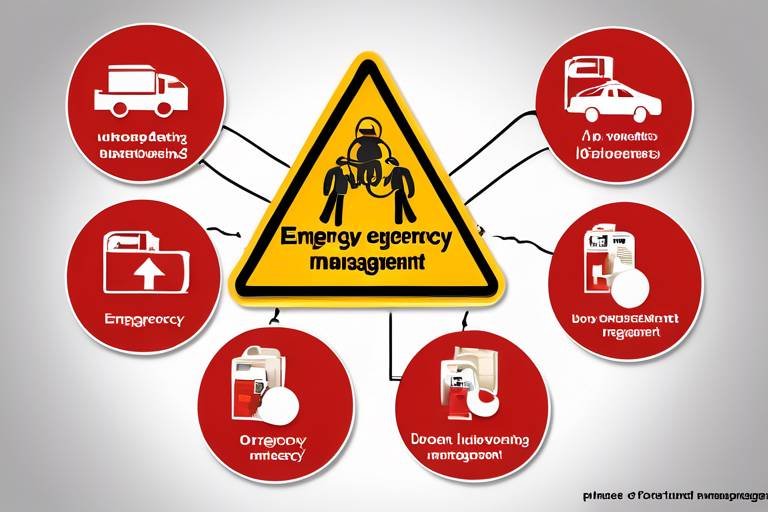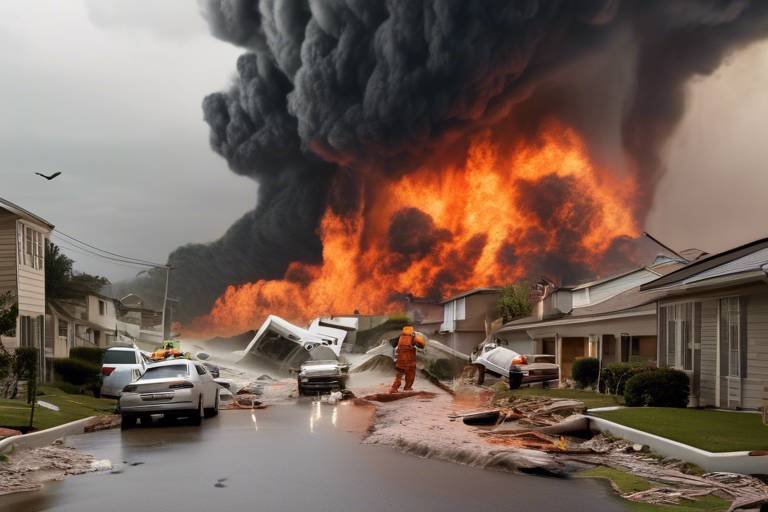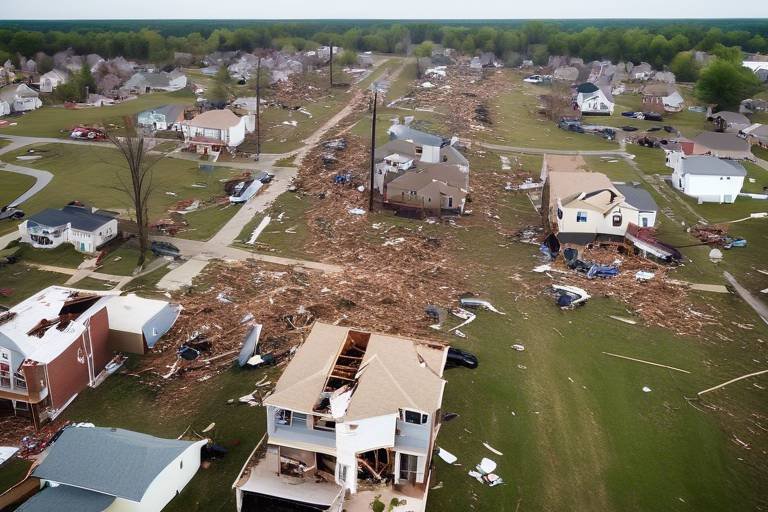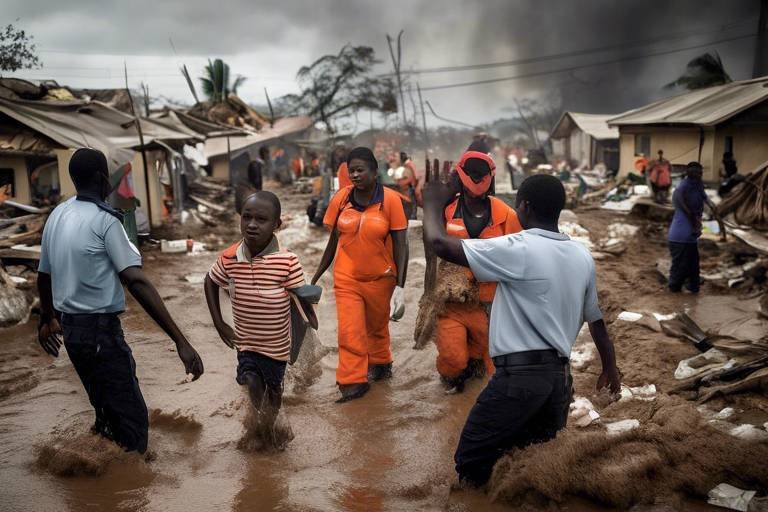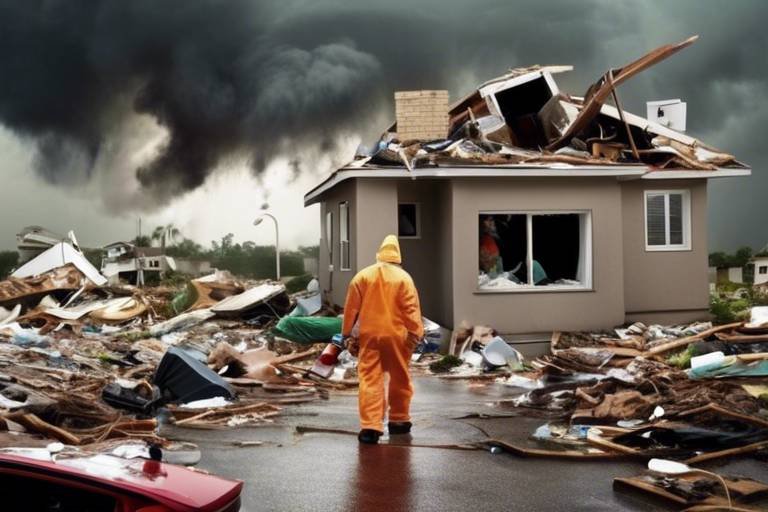Understanding the Phases of Emergency Management
When it comes to safeguarding our communities, understanding the critical phases of emergency management is essential. Think of emergency management as a well-oiled machine, with each phase acting as a cog that ensures the whole system runs smoothly. Whether it's a natural disaster, a public health crisis, or a man-made emergency, the phases of preparedness, response, recovery, and mitigation play a pivotal role in building resilience and ensuring safety. Just like a good story has a beginning, middle, and end, the emergency management cycle flows through these phases, each one leading to the next in a seamless manner.
Preparedness is the foundation upon which effective emergency management is built. This phase is all about planning and training, akin to an athlete preparing for a big game. It involves a thorough risk assessment to identify potential threats and vulnerabilities in a community. By understanding what could go wrong, communities can allocate resources more effectively and develop comprehensive response plans. Additionally, community education is crucial; it ensures that everyone knows what to do in case of an emergency. Imagine if everyone in your neighborhood knew exactly where to go and what to do during a disaster—this level of preparedness can significantly enhance readiness and save lives.
When an emergency strikes, the response phase kicks into gear. This is where the action happens! It focuses on immediate actions taken to address the situation at hand. Think of it as the first responders rushing to the scene of an accident. This phase includes mobilizing resources, coordinating various agencies, and providing assistance to those affected. The goal is to minimize harm and ensure safety as quickly as possible. For instance, during a hurricane, emergency services must work together to evacuate residents, provide medical care, and restore essential services. The clock is ticking, and every second counts!
Once the immediate danger has passed, the recovery phase begins. This phase is like the phoenix rising from the ashes, focusing on restoring and rebuilding communities after a disaster. Recovery encompasses both short-term and long-term efforts. Short-term recovery might involve providing shelter and food to those displaced, while long-term recovery addresses rebuilding infrastructure and restoring economic stability. It's a complex process that requires careful planning and collaboration among various stakeholders. Recovery is not just about physical restoration; it also involves addressing the emotional and psychological impacts of the disaster on individuals and communities.
Mitigation is the proactive phase of emergency management, aiming to reduce the severity and impact of future emergencies. Think of it as putting on a seatbelt before driving—you're taking steps to protect yourself before an accident happens. This phase involves implementing strategies and policies that minimize risks. These can include infrastructure improvements, land-use planning, and community awareness programs. For example, building levees in flood-prone areas can significantly lessen the impact of future flooding events. By investing in mitigation, communities can create a safer environment and enhance their overall resilience.
Effective emergency management relies heavily on collaboration among various stakeholders. It's like a symphony, where each musician plays their part to create beautiful music. Coordination between government agencies, non-profits, and the private sector is essential for enhancing response efforts. Each entity brings unique resources and expertise to the table, allowing for a more comprehensive approach to managing emergencies. For example, local governments may partner with non-profits to provide immediate relief, while private companies can offer logistical support. When everyone works together, the result is a more effective and efficient response to crises.
Community involvement is the heartbeat of successful emergency management. Engaging local residents in planning and response efforts fosters resilience and empowers individuals to take proactive steps in safeguarding their communities. When people feel a sense of ownership over their safety, they are more likely to participate in preparedness activities, such as drills and training sessions. Moreover, communities that work together during emergencies can share resources, information, and support, making recovery faster and more effective. Think of it as a neighborhood watch, but for emergencies—when everyone is involved, the community becomes stronger.
Regular training and exercises are crucial for ensuring preparedness. Just like athletes practice to hone their skills, emergency responders must engage in simulations and drills to be ready for real-life situations. These exercises allow responders to practice their roles, improve coordination, and identify areas for improvement. For instance, conducting a mock disaster scenario can reveal gaps in communication or resource allocation that need to be addressed. By investing time in training, communities can ensure that their responders are equipped with the skills and knowledge necessary to handle emergencies effectively.
In today's digital age, technology plays a vital role in modern emergency management. From Geographic Information Systems (GIS) that help map disaster areas to social media platforms that disseminate critical information, technology enhances communication, planning, and response efforts during crises. Mobile applications can provide real-time updates to residents, keeping them informed and safe. The integration of technology not only streamlines operations but also fosters greater community engagement. Imagine receiving alerts on your phone about an approaching storm—technology keeps us connected and informed, which is invaluable during emergencies.
Despite advancements in emergency management, numerous challenges persist. Climate change, resource limitations, and the need for innovative approaches to improve resilience and response strategies are ongoing issues. As we look to the future, it's crucial to adapt and evolve our methods. Communities must prioritize sustainability and invest in technologies that enhance preparedness and response. By addressing these challenges head-on, we can create a more resilient society, better equipped to handle whatever emergencies may come our way.
- What is the most critical phase of emergency management? Each phase is important, but preparedness often sets the stage for effective response and recovery.
- How can I get involved in my community's emergency management efforts? Look for local organizations that focus on disaster preparedness and volunteer for training sessions or community drills.
- What role does technology play in emergency management? Technology enhances communication, planning, and response efforts, making it easier to manage emergencies effectively.

Preparedness
is the bedrock of effective emergency management. It’s not just about having a plan; it’s about creating a culture of readiness within communities. Imagine being in a boat during a storm, and instead of frantically searching for life jackets, you’ve already secured them in advance. That’s what preparedness is all about—anticipating challenges and equipping ourselves to face them head-on.
The first step in this crucial phase is risk assessment. This involves identifying potential hazards that could impact a community, whether they are natural disasters like hurricanes and floods or human-made incidents such as industrial accidents. By understanding these risks, communities can prioritize their resources and efforts effectively. For example, a town located near a river may focus on flood preparedness, while a city in a seismic zone would prioritize earthquake drills.
Once risks are identified, the next step is resource allocation. Communities must determine what resources are available and what additional resources are needed to enhance their readiness. This could involve everything from stockpiling emergency supplies, such as food and water, to ensuring that first responders have the training and equipment necessary to act swiftly during a crisis. A well-prepared community might have the following resources:
| Resource Type | Examples |
|---|---|
| Emergency Supplies | Food, water, first aid kits |
| Training Programs | CPR training, emergency response drills |
| Communication Tools | Radios, mobile apps, social media |
But preparedness doesn’t stop at resource allocation; it also involves community education. Engaging residents in learning about emergency procedures and safety measures can significantly enhance a community’s resilience. Workshops, community meetings, and drills are excellent ways to disseminate knowledge and ensure everyone knows their role in an emergency. For instance, knowing how to create a family emergency plan and practicing it can make all the difference when disaster strikes.
Moreover, preparedness encourages individuals to take personal responsibility. It’s about empowering people to not only rely on emergency services but also to be active participants in their safety. When individuals know how to respond to an emergency, they become valuable assets to their community. This sense of empowerment fosters a collective spirit, where everyone works together to enhance overall safety.
In conclusion, the preparedness phase is a multifaceted approach that combines risk assessment, resource allocation, and community education. It’s about creating a proactive mindset that anticipates challenges and equips individuals and communities with the tools they need to navigate emergencies effectively. As the saying goes, “An ounce of prevention is worth a pound of cure.” By investing time and resources into preparedness, communities can significantly reduce the impact of disasters and enhance their resilience.
- What is the primary goal of preparedness? The main goal of preparedness is to ensure that individuals and communities are equipped to respond effectively to emergencies, minimizing harm and facilitating recovery.
- How can I get involved in my community's preparedness efforts? You can participate by attending local workshops, volunteering with emergency services, or simply educating yourself and others about safety measures.
- What should be included in a family emergency plan? A family emergency plan should include contact information, meeting places, emergency supplies, and specific roles for each family member during a crisis.

Response
The response phase of emergency management is akin to the heart of a well-oiled machine, pumping vital resources and actions into the community when disaster strikes. This crucial phase focuses on the immediate actions taken during an emergency to minimize harm and ensure safety. Imagine a fire alarm ringing in the dead of night; within moments, firefighters spring into action, coordinating their efforts to extinguish flames and rescue those in peril. This is the essence of the response phase—swift, decisive, and organized action.
During this phase, the first responders, including firefighters, police officers, and medical personnel, mobilize to tackle the emergency head-on. Their primary goal is to save lives and protect property. Coordination among various agencies is essential, as it allows for a more effective response. Think of it as a symphony where each musician plays a crucial role, and only by working together can they create a harmonious outcome. The key elements of the response phase include:
- Mobilizing Resources: This involves deploying personnel and equipment to the affected areas. Resources can include ambulances, rescue teams, and emergency supplies.
- Coordinating Agencies: Various organizations, from local governments to non-profits and even the military, may need to work together. Effective communication is vital to ensure everyone is on the same page.
- Providing Assistance: Responders must assess the needs of affected individuals and communities, offering medical aid, shelter, and food as necessary.
Moreover, situational awareness is paramount during the response phase. Emergency managers must continuously gather and analyze information to adapt their strategies. This can include monitoring weather conditions, assessing damage, and understanding the needs of the population. Advanced technologies, such as Geographic Information Systems (GIS), play a pivotal role in this aspect, allowing responders to visualize the situation, track resources, and make informed decisions.
One cannot overlook the emotional toll that emergencies take on affected individuals. The response phase also focuses on mental health support, as trauma can linger long after the physical dangers have passed. Providing psychological first aid and connecting individuals with mental health resources is just as important as addressing physical injuries.
In summary, the response phase of emergency management is a dynamic and multifaceted process. It requires quick thinking, effective coordination, and a compassionate approach to ensure the safety and well-being of the community. By understanding the intricacies of this phase, we can better appreciate the hard work and dedication of those who rush to our aid in times of crisis.
Q1: What is the primary goal of the response phase?
A1: The primary goal of the response phase is to minimize harm, save lives, and protect property during an emergency.
Q2: Who are the key players during the response phase?
A2: Key players include first responders such as firefighters, police officers, medical personnel, and various government and non-profit organizations.
Q3: How does technology assist in the response phase?
A3: Technology, including GIS and communication tools, helps in monitoring the situation, coordinating resources, and making informed decisions.
Q4: Why is emotional support important during emergencies?
A4: Emotional support is crucial as trauma can have long-lasting effects. Addressing mental health needs is essential for comprehensive recovery.

Recovery
Recovery is a crucial phase in the emergency management cycle, often overlooked but vital for restoring normalcy after a disaster. Imagine a community struck by a devastating hurricane; the initial shock and chaos can leave residents feeling lost and overwhelmed. Recovery isn't just about fixing what was broken; it's about rebuilding lives, restoring hope, and creating a stronger foundation for the future. This phase can be broken down into two key components: short-term recovery and long-term recovery.
Short-term recovery focuses on immediate needs. This includes providing essential services such as food, shelter, and medical care. Think of it as a first aid kit for a community; it’s about addressing urgent needs to stabilize the situation. Local governments and organizations often work together to set up emergency shelters and provide resources. For example, food banks may distribute meals, while healthcare providers offer medical assistance to those affected. The goal here is to ensure that everyone has access to the basic necessities for survival.
On the other hand, long-term recovery is where the real transformation happens. This phase can take years, even decades, as communities work to rebuild infrastructure, restore economic stability, and address the emotional impacts of the disaster. It’s like planting a garden after a storm; while the soil may be damaged, with care and attention, new life can flourish. Long-term recovery involves various aspects, including:
- Infrastructure Repair: Rebuilding roads, bridges, and public facilities to ensure safe access and functionality.
- Economic Recovery: Supporting local businesses through grants and loans to stimulate job creation and economic growth.
- Emotional and Psychological Support: Offering counseling and support groups to help individuals cope with trauma and loss.
Moreover, community involvement is essential in the recovery phase. Residents who actively participate in recovery efforts not only help restore their environment but also foster a sense of ownership and resilience. Engaging the community in planning and decision-making ensures that recovery efforts reflect the needs and desires of those most affected. After all, who knows a community better than its own residents?
To illustrate the recovery process, let’s look at a simplified table outlining the key actions and timeframes involved in both short-term and long-term recovery:
| Recovery Phase | Key Actions | Timeframe |
|---|---|---|
| Short-term Recovery |
|
Days to Weeks |
| Long-term Recovery |
|
Months to Years |
In summary, recovery is not a linear process; it's a complex journey that requires time, patience, and collaboration. While the scars of a disaster may linger, the resilience of a community shines through as they come together to rebuild and emerge stronger than before. Remember, recovery is not just about returning to the way things were; it’s about creating a better, more resilient future.
Q1: How long does the recovery phase typically last?
A1: The recovery phase can vary significantly depending on the disaster's severity, ranging from a few months for minor incidents to several years for major catastrophes.
Q2: What role do volunteers play in the recovery process?
A2: Volunteers are crucial in recovery efforts, providing labor, resources, and emotional support to affected individuals and communities.
Q3: How can communities prepare for the recovery phase in advance?
A3: Communities can enhance their recovery readiness by developing comprehensive recovery plans, engaging local stakeholders, and conducting regular training and simulations.

Mitigation
is like the safety net we set up before the tightrope walk of life begins. It's all about reducing the risks and impacts of future emergencies before they even happen. Think of it as the proactive approach to emergency management, where we take steps to lessen the blow of disasters, whether they’re natural calamities like hurricanes or man-made crises such as industrial accidents.
In this phase, communities and governments work together to implement strategies that can significantly minimize potential hazards. For instance, infrastructure improvements play a crucial role. By reinforcing buildings to withstand earthquakes or elevating roads in flood-prone areas, we are essentially fortifying our defenses against nature’s fury. But mitigation isn’t just about physical structures; it also encompasses land-use planning. This involves making informed decisions about where to build homes, schools, and businesses, ensuring they are situated in safer areas. The goal is to keep our communities safe and sound, even when the unexpected strikes.
Another vital aspect of mitigation is community awareness programs. Educating the public about potential risks and how to prepare for them is essential. When communities are informed, they become empowered to take action. Here are some common mitigation strategies:
- Implementing strict building codes to ensure structures can withstand disasters.
- Creating green spaces to absorb rainfall and reduce flooding.
- Conducting regular risk assessments to identify vulnerabilities.
- Encouraging local businesses to develop disaster recovery plans.
Moreover, it's crucial to recognize that effective mitigation requires collaboration among various stakeholders. Local governments, non-profits, and community members must work in tandem to create a comprehensive plan that addresses specific risks unique to their area. This teamwork can lead to innovative solutions—like utilizing technology to model disaster scenarios, which helps in understanding potential impacts and preparing accordingly.
In summary, mitigation is not just a checkbox on an emergency management plan; it’s a fundamental phase that lays the groundwork for community resilience. By investing time and resources into mitigation strategies, we can significantly reduce the risks associated with disasters, ultimately saving lives and minimizing economic losses. So, the next time you hear about a community facing a disaster, remember that their strength lies in the precautions they've taken long before the storm hits.
Q1: What is the primary goal of mitigation in emergency management?
A1: The primary goal of mitigation is to reduce the severity and impact of future emergencies through proactive strategies, such as infrastructure improvements and community education.
Q2: How can communities get involved in mitigation efforts?
A2: Communities can engage in mitigation by participating in local planning meetings, volunteering for awareness programs, and advocating for policies that prioritize safety and risk reduction.
Q3: What role does technology play in mitigation?
A3: Technology enhances mitigation efforts by providing tools for risk assessment, modeling disaster scenarios, and facilitating communication during emergencies.
Q4: Why is collaboration important in the mitigation phase?
A4: Collaboration among various stakeholders ensures that all perspectives are considered, leading to more comprehensive and effective mitigation strategies tailored to specific community needs.

Collaboration and Coordination
Effective emergency management is not a solo endeavor; it thrives on the synergy created through collaboration and coordination among various stakeholders. Imagine a well-orchestrated symphony where each musician plays their part harmoniously to produce a beautiful melody. Similarly, in emergency management, different entities must work together to ensure a seamless response to crises. This collaboration involves government agencies, non-profit organizations, private sector companies, and the community at large.
One of the key elements of successful collaboration is the establishment of clear communication channels. When an emergency strikes, the last thing you want is confusion and miscommunication. By fostering open lines of communication, stakeholders can share vital information quickly and efficiently. For instance, during a natural disaster, local authorities need to communicate with emergency services to deploy resources effectively. This is where technology plays a crucial role, providing platforms for real-time updates and information dissemination.
Moreover, coordination among various agencies helps to eliminate redundancy and ensures that resources are utilized optimally. This can be likened to a well-planned sports team where each player knows their role and works towards a common goal. For example, in the aftermath of a hurricane, various agencies might be responsible for different aspects of recovery: one might focus on debris removal, while another addresses housing needs for displaced families. By coordinating these efforts, the overall recovery process becomes more efficient and effective.
Furthermore, collaboration extends beyond immediate response efforts. It also encompasses long-term planning and preparedness. Regular meetings and joint exercises can help build relationships and trust among stakeholders. These proactive measures ensure that when an emergency arises, everyone is well-versed in their roles and responsibilities. It’s like rehearsing for a play; the more you practice, the smoother the performance on the big night.
To illustrate the importance of collaboration, consider the following table that outlines the roles of different stakeholders during an emergency:
| Stakeholder | Role |
|---|---|
| Government Agencies | Coordinate response efforts, allocate resources, and implement policies. |
| Non-Profit Organizations | Provide immediate assistance, such as food, shelter, and medical care. |
| Private Sector | Offer logistical support, technology solutions, and funding. |
| Community Members | Participate in planning, volunteer, and assist in local response efforts. |
In conclusion, the essence of effective emergency management lies in the ability to collaborate and coordinate. By building strong partnerships and fostering a culture of teamwork, communities can enhance their resilience and preparedness. As the saying goes, “Alone we can do so little; together we can do so much.” In the face of disasters, this collaborative spirit becomes not just beneficial, but essential for safeguarding lives and property.
- Why is collaboration important in emergency management?
Collaboration ensures that resources are used effectively, reduces redundancy, and improves communication during a crisis. - How can communities foster better coordination?
Communities can foster better coordination through regular training, joint exercises, and establishing clear communication channels among stakeholders. - What role does technology play in collaboration?
Technology facilitates real-time communication, data sharing, and enhances overall coordination efforts among various agencies and organizations.

Community Involvement
Community involvement is the backbone of successful emergency management. When local residents actively participate in planning and response efforts, the entire community becomes more resilient. Think of it like a team sport; everyone has a role to play, and when individuals come together, they can tackle challenges more effectively. Engaging community members not only empowers them but also fosters a sense of ownership and responsibility towards their surroundings.
One of the most effective ways to enhance community involvement is through education and outreach programs. These initiatives help residents understand the risks they face and the steps they can take to prepare for emergencies. For instance, organizing workshops or information sessions can equip individuals with essential skills, such as first aid, emergency communication, and disaster preparedness. This knowledge is invaluable, especially during high-stress situations when quick thinking and action are crucial.
Moreover, community involvement can take many forms, from volunteer programs to neighborhood watch groups. By encouraging residents to participate in local emergency response teams, communities can create a network of trained volunteers who are ready to assist during crises. This not only alleviates the burden on professional responders but also enhances the overall safety of the area. When people know their neighbors and understand each other's strengths, they can work together more efficiently in times of need.
To illustrate the impact of community involvement, consider the following table that highlights key benefits:
| Benefit | Description |
|---|---|
| Increased Awareness | Community members are more informed about potential risks and preparedness strategies. |
| Stronger Networks | Building relationships among residents fosters collaboration and quick response during emergencies. |
| Resource Sharing | Communities can pool resources, such as tools and skills, to enhance their emergency response capabilities. |
| Empowerment | Residents feel more in control and capable of handling emergencies, reducing panic and confusion. |
In conclusion, community involvement is not just a nice-to-have; it's a necessity for effective emergency management. By fostering an environment where residents are informed, engaged, and prepared, communities can significantly improve their resilience against disasters. So, how can you get involved? Whether it’s joining a local preparedness group, participating in training sessions, or simply sharing information with your neighbors, every little action counts. Remember, in times of crisis, it’s the strength of the community that often makes the difference between chaos and order.
- How can I get involved in my community's emergency management efforts?
You can start by attending local meetings, volunteering for community response teams, or participating in training sessions offered by local organizations.
- What are some effective ways to educate my neighbors about emergency preparedness?
Consider hosting workshops, distributing flyers with important information, or creating a neighborhood social media group to share resources and tips.
- Why is community involvement important during emergencies?
Community involvement ensures that residents are prepared, informed, and able to respond effectively, which can save lives and reduce damage during a disaster.

Training and Exercises
This article explores the critical phases of emergency management, detailing preparedness, response, recovery, and mitigation, while emphasizing the importance of each phase in ensuring community resilience and safety.
Preparedness involves planning and training to ensure effective responses to emergencies. This phase includes risk assessment, resource allocation, and community education to enhance readiness for potential disasters.
The response phase focuses on immediate actions taken during an emergency. It includes mobilizing resources, coordinating agencies, and providing assistance to affected individuals and communities to minimize harm and ensure safety.
Recovery is the process of restoring and rebuilding after an emergency. It encompasses short-term and long-term efforts to return communities to normalcy, addressing physical, emotional, and economic impacts of the disaster.
Mitigation aims to reduce the severity and impact of future emergencies. This phase involves implementing strategies and policies that minimize risks, such as infrastructure improvements, land-use planning, and community awareness programs.
Effective emergency management relies on collaboration among various stakeholders. This section discusses the importance of coordination between government agencies, non-profits, and the private sector in enhancing response efforts.
Community involvement is vital for successful emergency management. Engaging local residents in planning and response efforts fosters resilience and empowers individuals to take proactive steps in safeguarding their communities.
Regular training and exercises are essential for preparedness. Just like an athlete trains for a big game, emergency responders must practice their skills to ensure they are ready when disaster strikes. Conducting simulations and drills allows responders to experience real-life scenarios in a controlled environment, enhancing their decision-making and teamwork capabilities.
Training programs should focus on a variety of scenarios, including natural disasters, public health emergencies, and man-made incidents. This broad approach ensures that responders can adapt to any situation. Here are some key components of effective training:
- Realistic Simulations: Creating lifelike scenarios that mimic potential emergencies helps responders practice their skills effectively.
- Inter-agency Coordination: Exercises that involve multiple agencies foster collaboration and improve communication during actual events.
- Feedback Mechanisms: After each drill, participants should debrief to discuss what went well and what could be improved.
Moreover, technology can greatly enhance training efforts. Virtual reality (VR) and augmented reality (AR) tools can immerse responders in simulated environments, providing a safe space to practice high-stakes decision-making. This innovative approach not only makes training more engaging but also prepares responders for the unexpected.
In summary, regular training and exercises are not just beneficial; they are crucial for ensuring that emergency management teams are prepared to respond effectively. By investing time and resources into these practices, communities can bolster their resilience and safeguard their citizens in times of crisis.
Technology plays a crucial role in modern emergency management. This section explores how tools like GIS, social media, and mobile applications enhance communication, planning, and response efforts during crises.
Despite advancements, emergency management faces numerous challenges. This section discusses ongoing issues such as climate change, resource limitations, and the need for innovative approaches to improve resilience and response strategies.
Q: Why is training important in emergency management?
A: Training ensures that responders are prepared for real-life scenarios, enhancing their skills and teamwork.
Q: What role does technology play in emergency management?
A: Technology improves communication, planning, and response efforts, making it easier to manage crises effectively.
Q: How can community involvement enhance emergency management?
A: Engaging local residents fosters resilience and empowers them to take proactive steps in safeguarding their communities.

Technology in Emergency Management
This article explores the critical phases of emergency management, detailing preparedness, response, recovery, and mitigation, while emphasizing the importance of each phase in ensuring community resilience and safety.
Preparedness involves planning and training to ensure effective responses to emergencies. This phase includes risk assessment, resource allocation, and community education to enhance readiness for potential disasters.
The response phase focuses on immediate actions taken during an emergency. It includes mobilizing resources, coordinating agencies, and providing assistance to affected individuals and communities to minimize harm and ensure safety.
Recovery is the process of restoring and rebuilding after an emergency. It encompasses short-term and long-term efforts to return communities to normalcy, addressing physical, emotional, and economic impacts of the disaster.
Mitigation aims to reduce the severity and impact of future emergencies. This phase involves implementing strategies and policies that minimize risks, such as infrastructure improvements, land-use planning, and community awareness programs.
Effective emergency management relies on collaboration among various stakeholders. This section discusses the importance of coordination between government agencies, non-profits, and the private sector in enhancing response efforts.
Community involvement is vital for successful emergency management. Engaging local residents in planning and response efforts fosters resilience and empowers individuals to take proactive steps in safeguarding their communities.
Regular training and exercises are essential for preparedness. This section highlights the significance of simulations and drills in ensuring that responders are equipped with the skills and knowledge needed during emergencies.
In today's digital age, technology plays a crucial role in enhancing emergency management efforts. It's like having a superhero sidekick that helps first responders do their jobs more effectively and efficiently. From geographic information systems (GIS) that visualize data to social media platforms that facilitate real-time communication, technology has transformed how we prepare for, respond to, and recover from emergencies.
For instance, GIS technology allows emergency managers to analyze spatial data, helping them identify vulnerable areas and allocate resources more effectively. Imagine being able to see a map that highlights flood-prone regions or wildfire risks; this insight can be invaluable in planning evacuations and resource distribution.
Moreover, mobile applications have emerged as powerful tools for both responders and the public. These apps can provide crucial information during a crisis, such as emergency alerts, shelter locations, and safety tips. By keeping the community informed, technology enhances overall preparedness and response efforts.
Social media, too, has become a double-edged sword in emergency management. While it can spread misinformation, it also serves as a platform for real-time updates and community engagement. Agencies can use platforms like Twitter and Facebook to disseminate information quickly, allowing people to stay informed and make safer choices during emergencies.
However, it's important to note that the integration of technology in emergency management is not without its challenges. Issues such as data privacy, cybersecurity, and the digital divide must be addressed to ensure that all community members can benefit from technological advancements.
In conclusion, as we look to the future, the role of technology in emergency management will only continue to grow. By leveraging these tools, communities can enhance their resilience and improve their ability to respond to and recover from disasters.
Despite advancements, emergency management faces numerous challenges. This section discusses ongoing issues such as climate change, resource limitations, and the need for innovative approaches to improve resilience and response strategies.
- What is the most critical phase of emergency management? Each phase—preparedness, response, recovery, and mitigation—is vital, but preparedness often sets the groundwork for effective response and recovery.
- How can technology improve emergency response? Technology enhances communication, data analysis, and resource allocation during emergencies, leading to more efficient and effective responses.
- Why is community involvement important? Engaging the community fosters resilience and empowers individuals to take proactive steps, making them better prepared for emergencies.

Challenges and Future Directions
Despite significant advancements in emergency management, the landscape is constantly evolving, presenting new challenges that demand innovative solutions. One of the most pressing issues is the impact of climate change, which has led to an increase in the frequency and intensity of natural disasters. As temperatures rise and weather patterns shift, communities must adapt their emergency management strategies to address these unpredictable threats.
Another critical challenge is the limitation of resources. Many regions, especially those that are economically disadvantaged, struggle to allocate sufficient funds and personnel for effective emergency management. This often results in inadequate training and preparedness, leaving communities vulnerable when disaster strikes. Furthermore, as populations grow and urban areas expand, the complexity of managing emergencies increases, requiring more coordination and collaboration among various stakeholders.
In addition to climate change and resource constraints, there is a growing need for innovative approaches to improve resilience and response strategies. Traditional methods may no longer suffice in the face of new technologies and evolving threats. For instance, integrating data analytics and artificial intelligence into emergency management can enhance predictive capabilities, allowing agencies to anticipate and mitigate potential disasters before they occur.
To tackle these challenges effectively, a multi-faceted approach is essential. This includes:
- Community Engagement: Involving local residents in planning and response efforts enhances resilience and empowers individuals.
- Interagency Collaboration: Coordinating efforts between government, non-profits, and the private sector can streamline resources and improve response times.
- Investment in Technology: Leveraging modern tools, such as GIS and mobile applications, can significantly enhance communication and planning.
Looking to the future, it is crucial to focus on building a culture of preparedness within communities. This involves not only educating the public about risks but also fostering a sense of personal responsibility for safety. By encouraging individuals to participate in training and preparedness exercises, we can create a more resilient society capable of withstanding and recovering from emergencies.
Moreover, as we navigate these challenges, it is essential to remain adaptable. The landscape of emergency management is ever-changing, and strategies must evolve accordingly. Embracing a proactive mindset will allow us to anticipate future challenges and develop robust solutions that protect communities and save lives.
Q1: What are the main phases of emergency management?
A1: The main phases of emergency management include preparedness, response, recovery, and mitigation. Each phase plays a crucial role in ensuring community resilience and safety.
Q2: How can communities prepare for emergencies?
A2: Communities can prepare for emergencies by conducting risk assessments, creating emergency plans, providing training and resources, and engaging local residents in preparedness activities.
Q3: What role does technology play in emergency management?
A3: Technology enhances emergency management by improving communication, planning, and response efforts. Tools like GIS, social media, and mobile applications are crucial for effective coordination during crises.
Q4: Why is community involvement important in emergency management?
A4: Community involvement fosters resilience and empowers individuals to take proactive steps in safeguarding their communities, ensuring a more effective response during emergencies.
Frequently Asked Questions
- What are the key phases of emergency management?
The key phases of emergency management are preparedness, response, recovery, and mitigation. Each phase plays a crucial role in ensuring that communities can effectively handle emergencies and bounce back from disasters.
- How can I prepare my community for emergencies?
Preparing your community involves conducting risk assessments, organizing training sessions, and developing emergency plans. Engaging local residents and educating them about potential risks can significantly enhance overall readiness.
- What actions are taken during the response phase?
During the response phase, immediate actions are taken to address the emergency. This includes mobilizing resources, coordinating with various agencies, and providing assistance to those affected to minimize harm and ensure safety.
- What does recovery entail after an emergency?
Recovery involves both short-term and long-term efforts to restore normalcy in the community. This can include rebuilding infrastructure, providing psychological support, and addressing economic impacts caused by the disaster.
- How does mitigation help in emergency management?
Mitigation aims to reduce the potential impact of future emergencies by implementing strategies like infrastructure improvements and land-use planning. It’s about being proactive rather than reactive!
- Why is collaboration important in emergency management?
Collaboration among government agencies, non-profits, and the private sector enhances response efforts. It ensures that resources are used efficiently and that there is a unified approach to tackling emergencies.
- How can technology improve emergency management?
Technology plays a vital role by providing tools like GIS for mapping, social media for communication, and mobile applications for real-time updates. These tools help streamline planning and response efforts during crises.
- What challenges does emergency management face today?
Emergency management faces challenges such as climate change, resource limitations, and the need for innovative strategies. Addressing these issues is crucial for improving resilience and response capabilities in the future.

